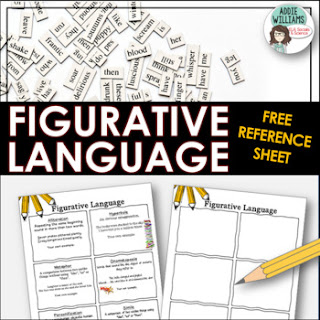Once students understand the different types of figurative language, they love using it! However, finding the right activities to use can be challenging. For instance, if students learn too many types at once, they get confused. This is why teachers work so hard to select engaging, hands-on activities. Luckily, there are tons of great options below to ensure students understand how cool figurative language is.
FREE Figurative Language Reference Sheet
Between similes, metaphors, and personification, there are many definitions to keep straight. Luckily, this reference sheet is here to help students! It provides definitions and examples for alliteration, hyperbole, onomatopoeia, simile, metaphor, and personification. Additionally, there is space for students to create their own examples. They will love doing this and be eager to share their examples with classmates.
There is even a blank space for students to add additional terms as they learn them!
When teaching figurative language, students must apply the different types to their work. So, students will write about their pet peeves using creative similes. Honestly, this is a great way to show their knowledge.
They will begin by brainstorming all of the things that irritate them and then create a poem filled with similes to describe their irritation. There are brainstorming pages, student examples, and writing templates included. There are even self-assessment rubrics and a teacher rubric. On top of this, there is a poetry analysis activity to help students comprehend poetry.
This is a student favorite every year! The entire class will be laughing at all of the hilarious similes!
Monster Poster Pack
When teaching figurative language, students will significantly benefit from visual aids. This will help them remember the definitions. Thankfully, this poster pack includes posters for figurative language, word wall strips, and a reference sheet.
Since language arts involve many terms, there are posters for essential concepts. This includes the different parts of speech and types of sentences. Students will love having these learning supports hung up around the classroom.
There are even reading vocabulary bookmarks! Students will love every minute of language arts with these resources.
Figurative Language Digital Flipbook
Honestly, it is so easy to confuse the different types of figurative language. To help ensure this does not happen to your students, this flipbook is the perfect way to learn and review key terms.
Students will focus on alliteration, hyperbole, metaphor, onomatopoeia, personification, and simile. They will define each type and find examples from a text. Then, they will apply this information as they make their examples.
Students will love creating and sharing their figurative language flipbooks!
Figurative Language Task Cards, Flip Book, and Interactive Notebook
When teaching figurative language, teachers work hard to make lessons interactive. Luckily, this resource contains so many activities that students will love! This is a great way to help ensure they do not become overwhelmed.
The activities focus on metaphor, simile, personification, hyperbole, onomatopoeia, rhyme, alliteration, and more! To learn these essential terms, there are 36 task cards. This is a great way to inspire poetry writing! Additionally, there is a figurative language/poetry term flip book. This allows students to learn the terms in fun, creative ways. Additionally, there are notebook templates for students to complete an engaging vocabulary matching activity.
Figurative language can be complex for students to learn. However, teaching figurative language can be a ton of fun! With the interactive activities above, students will learn figurative language and apply it to multiple skills. This includes creating examples and writing poetry. Students will have a blast learning figurative language!
If you do not want to miss any of the upcoming lessons, join my email list to be notified of all the interactive lessons coming up! By joining the email list, you will also receive a FREE FIgurative Language Reference Sheet for blog exclusive subscribers!






.jpg)









No comments